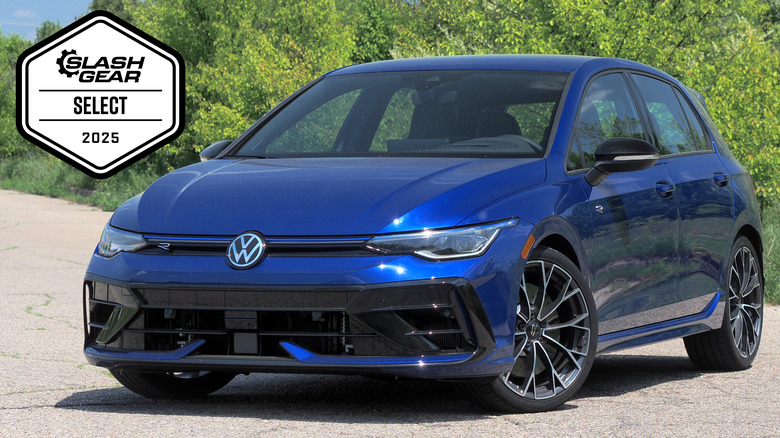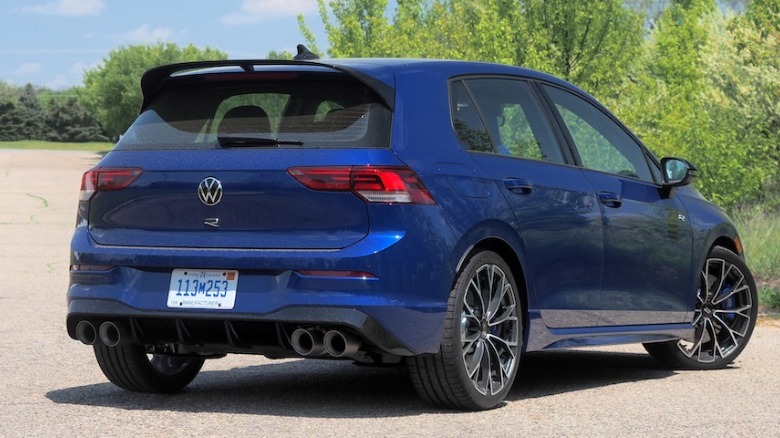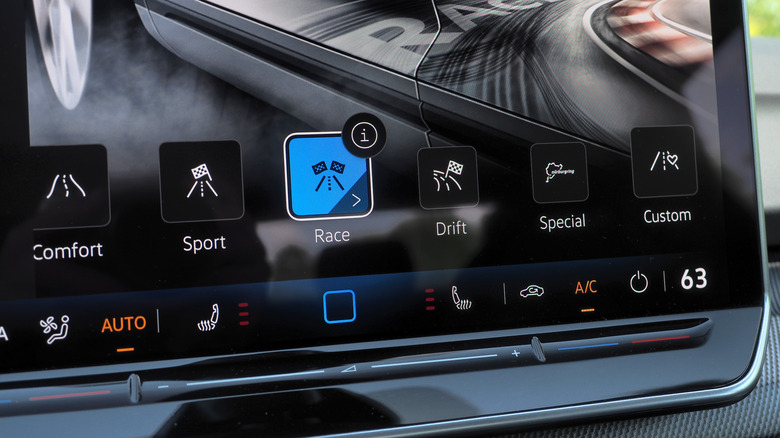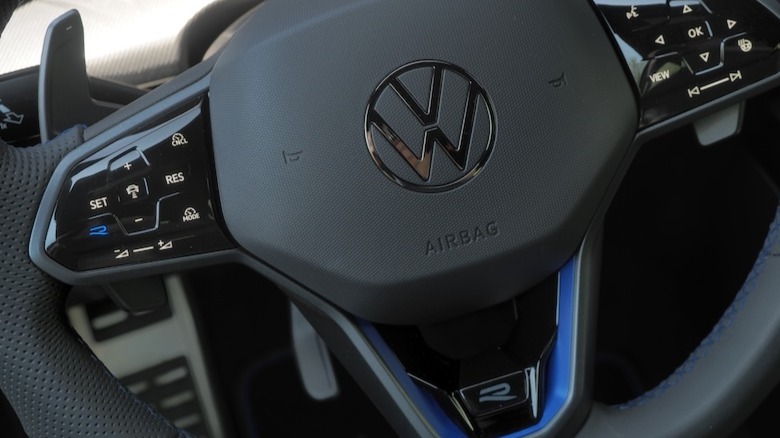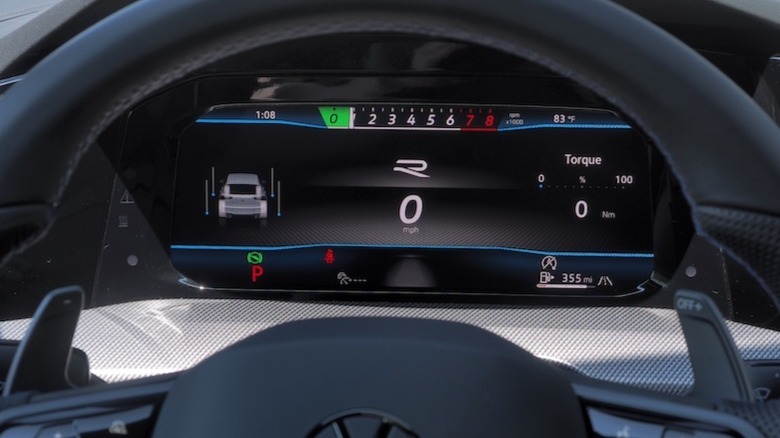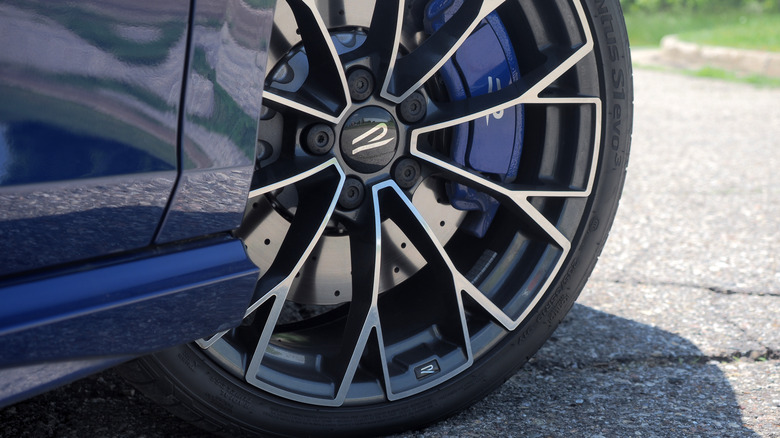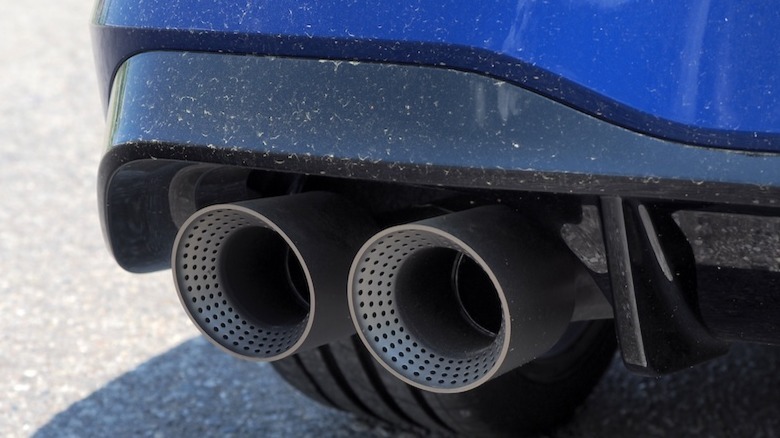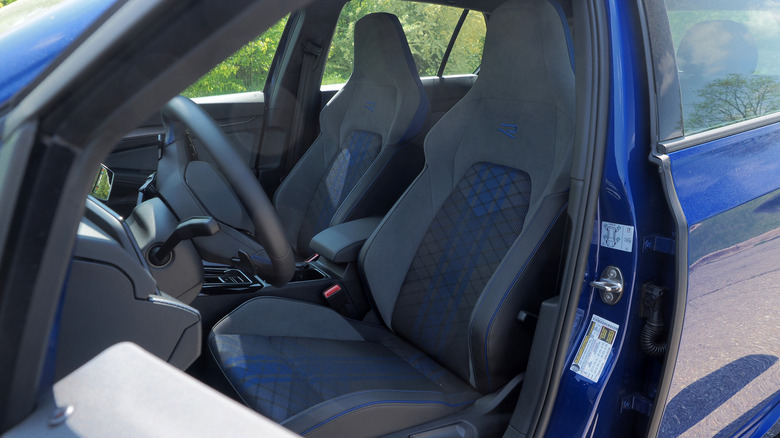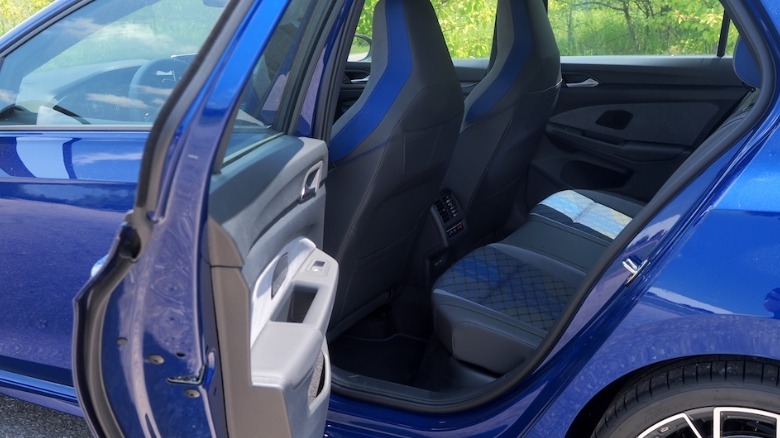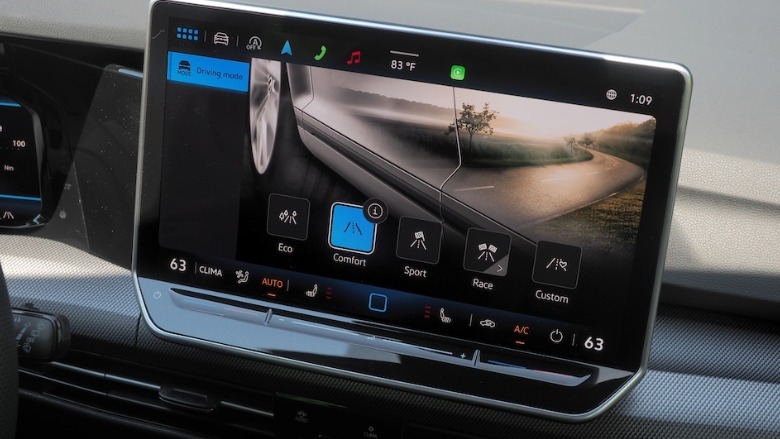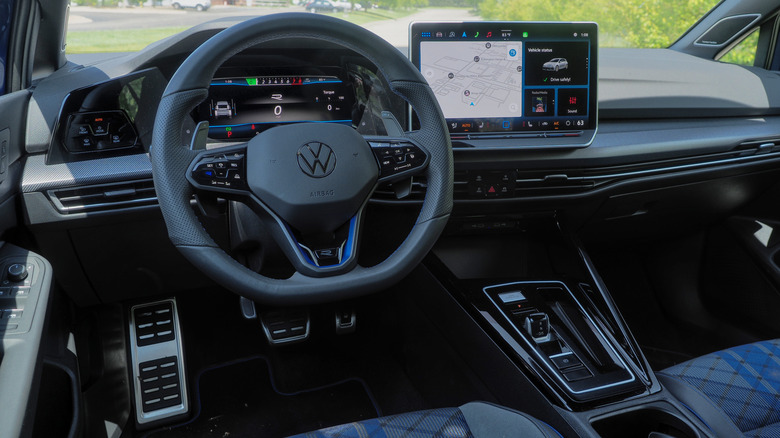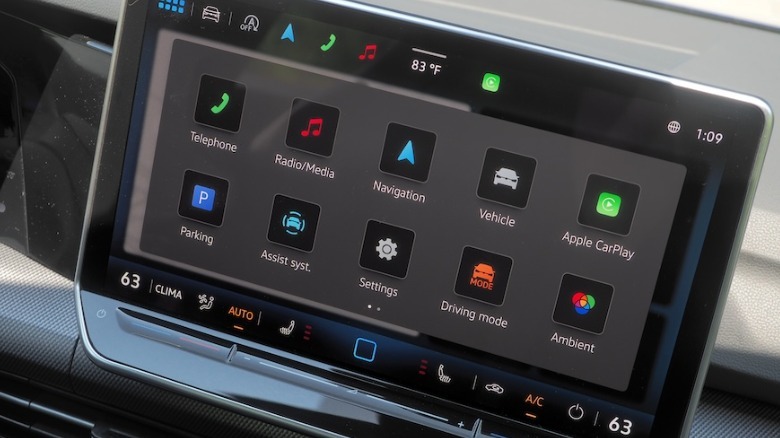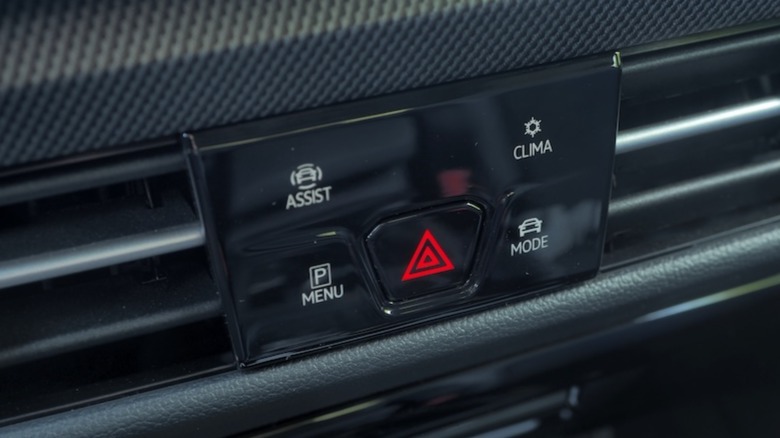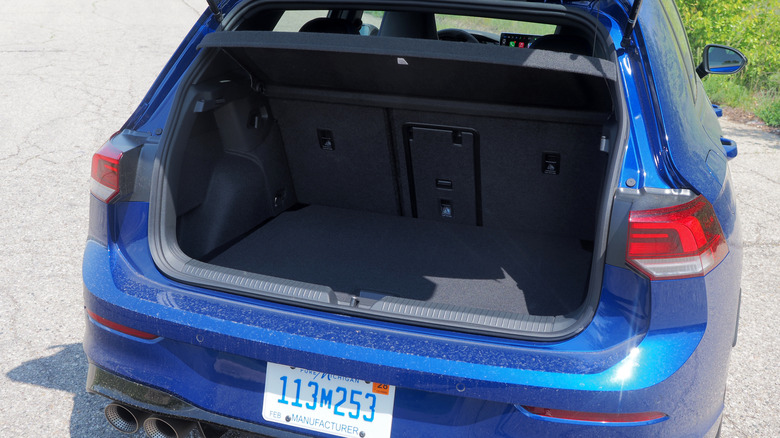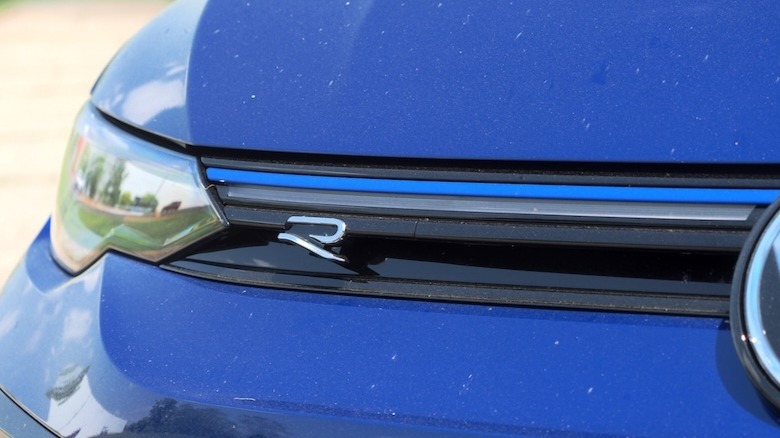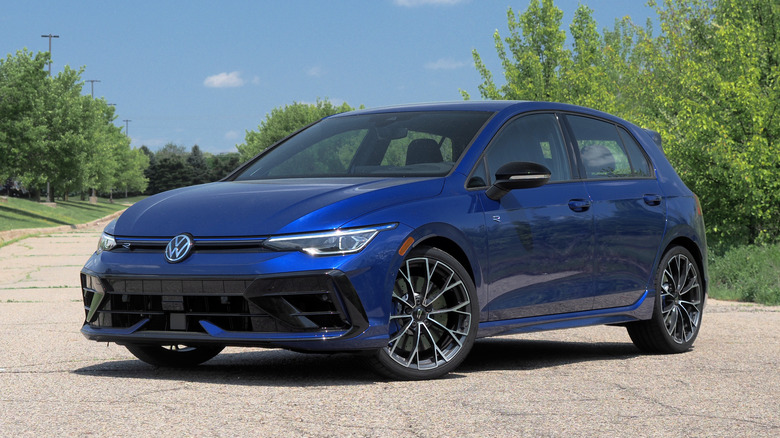2025 VW Golf R Review: The Hot Hatch Grew Up, For Better And Worse
- 2.0-turbo has more power than ever
- All-wheel drive delivers excellent grip
- All the practicality the Golf is known for
- No manual transmission option
- Not as gleefully giddy as rivals
- Tough decisions for interior spec
Against all odds, hot hatch fans are spoiled for choice right now. What once seemed like a dwindling segment now has compelling, quirky options from Honda, Toyota, Hyundai, and others, each hoping to overshadow cars like Volkswagen's 2025 Golf R. A mainstay of the segment, since the Golf R32 launched back in 2004 as the GTI's more well-rounded sibling, this newest R again promises driver engagement and everyday practicality for its $47,100 (plus $1,225 sticker).
On the outside, it's the Golf we know and — for the most part — love, with a new light bar across the front, an illuminated logo, and a redesigned bumper for 2025. A chunky little wedge, on standard 19-inch alloy wheels and your color options a scant blue, black, or white, it gets LED lights front and rear. A Black Edition drops the few blue branding touches of the standard Golf R, but either way it's a relatively sober car visually compared to, say, Toyota's bulging GR Corolla body kit.
There are no surprises under the hood, either, where Volkswagen's 2.0-liter turbo-four delivers 328 horsepower and 295 lb-ft of torque. It's enough to make it the most powerful Golf R yet (in terms of production models from the factory, at least), and arguably the easiest to live with, too. The standard 7-speed dual-clutch transmission contributes to that, of course, as does the reassurance of all-wheel drive and adaptive damping.
Soft when you want soft, firm when it's go-time
VW's adaptive damping can be more relaxed in Comfort and Eco modes, or firm up in Sport or Race modes. There are two sub-modes of Race, Special, and Drift, the former designed for maximum performance should you happen to be on Germany's Nürburgring Nordschleife track, while the latter helps encourage the Golf R to go sideways (with a warning not to enable Drift mode on public roads). A blue "R" button on the steering wheel summons Race mode instantly, complete with special cluster graphics.
While power is up over the previous-generation Golf R — by 13 horses — it's how that now reaches the road that's arguably more interesting. Like with the old car, up to 50% of total engine power can be pushed to the rear axle, to maximize performance and traction. Or the rear wheels can be decoupled altogether, for more frugal daily driving such as on the highway.
New, though, is rear-axle torque vectoring: a mechanical system with which the 2025 Golf R can push up to the entirety of the rear axle's power to either the left or right wheel. Combined with brake-based torque control — briefly slowing a wheel experiencing reduced traction — it gives the car more precise cornering talents, such as by shifting torque to the outside wheels in aggressive turns.
Is there such a thing as too capable?
The result of all that is a hot hatch that's eminently capable, with no shortage of grip and a heady shove of torque which — arguably — would've downplayed some of the stick shift advantages anyway. No need to downshift, if your turbo-four can simply pull regardless. In "S" mode, the transmission holds lower ratios for longer, and upshifts later; or you can weigh in yourself and use the paddles on the steering wheel to shift when you please. Do that in the Special and Drift modes and the gearbox will stick to manual mode rather than revert back to automatic; left in Auto, it'll simply keep the revs as high as possible.
Race mode is firm and shouty, helped by the optional titanium exhaust on this particular review car. It all feels very polished and controlled: Volkswagen's very best efforts to get power to the road, and where it will be most impactful. You can't really fault that, as a strategy — a sports car which squandered its capacities would be a misstep, of course — but the end result feels a little dimmed in personality. Part of the charm, for me, of "mainstream" performance cars is in wringing the best out of them: working around their foibles and particular characters.
The Golf R doesn't really seem to require that, it's just exceedingly polished. Point it at a corner, rely on that surfeit of grip and the wave of torque, and it zips eagerly and with a rousing little snarl. I feel vaguely ridiculous, for wishing it wasn't quite so adept, but part of me regretted that they'd not sent the new Golf GTI so that I'd at least have had to work around its front-wheel drive. Volkswagen clearly made a car that lives up to the Nürburgring, but that can feel over-equipped for back road silliness.
The best interior package comes with compromises
Inside, the head-versus-heart decisions continue. Like VW's other gas cars — as distinct from its EVs — the Golf R's cabin is a dark, relatively sober place. Leather seats get some blue accents, and there's carbon-gray and gloss black trim on the dashboard. Three-zone climate control, along with heated and ventilated front seats, plus heated outboard rear seats, are standard.
My head says that's just swell, but my heart can't resist the Golf R Euro Style Package fitted to this car, a $3,795 option. It gets you the retro-glorious diamond-patterned cloth seats with ArtVelours inserts, along with matching inserts on the door panels (plus that titanium exhaust). Problem is, it also swaps the standard sunroof for a solid roof, and you lose the front seat ventilation.
Unfortunately, there's no package to add physical HVAC controls to the dashboard; we're stuck with VW's finicky touch-sensitive sliders for that, and for adjusting volume. At least they're backlit, now. The sizable 12.9-inch touchscreen is standard, too, plus a head-up display and a fully digital instrument cluster.
VW makes most things standard
Wireless Apple CarPlay and Android Auto are supported, and there are USB-C charging ports for the front and rear seats, plus a wireless phone charging pad in the center console. A Harmon Kardon audio system is standard, too.
VW's infotainment system is reasonably straightforward to navigate, though can feel overwhelming at first. The cluster of four shortcut buttons below — to jump straight into drive mode adjustment, or the climate menu, for example — help, but there are a lot of different menus, widget and app-layout screens, and slide-down shortcut panels.
What physical controls you do get, meanwhile, feel somewhat underwhelming. The plastic engine start button is functional but hardly exciting; similarly, the little transmission shifter nub does the job, but nicer materials wouldn't go amiss. Maybe it sounds unfairly critical, to point out the solid-but-forgettable plastic of the Golf R's paddle shifters, but metal would've at least made interacting with the transmission feel more special.
You know what you're getting with a Golf
Generally, though, the reasons to pick a Golf — any Golf, though after 50+ years the line-up has dwindled in the U.S. – remain strong. The 19.9 cu-ft trunk isn't the largest in the segment, with a Civic Type R holding almost 5 cu-ft more, but it's a wide, easy to access and use space. Drop the 60/40 split rear bench (which also has a ski hatch cut-out) and it expands to 34.5 cu-ft.
Then there's fuel economy which, though 22 mpg in the city, 31 mpg on the highway, and 25 mpg combined isn't exactly going to win awards among cars of its size, still leaves the Golf R at a slight advantage over its Toyota and Honda rivals. A manual GR Corolla or Civic Type R are both rated for 24 mpg combined; the automatic GR Corolla is several points worse, at 22 mpg combined.
Obviously getting near those numbers requires driving with a degree of restraint. Still, duality has always been the name of the game with hot hatches, and with its softer suspension options and mildly better efficiency, Volkswagen's car is easier to live with. Even the automatic GR Corolla, for all it can change its own gears, still feels high-sprung and giddy in comparison to the stolid VW.
2025 VW Golf R Verdict
I like the new Golf R, in a lot of ways. It's fun to drive, practical both in terms of its hatchback design and the standard all-wheel drive, and Volkswagen skirts a careful line — mostly successfully — between ease of use and feeling tech-forward and modern. It doesn't fall too far into that "too powerful for its own good" trap, either, and slapping on a set of winter tires would undoubtedly leave it as poised in snow and ice, as it is in warmer months on the standard summer rubber.
All the same, the absence of a manual disappointed me more than I expected it to. Certainly, I acknowledge VW's argument that demand simply wasn't sufficiently strong in North America to make it viable here, and I can't complain on technical reasons about the swiftness of its automatic transmission. I bet a Golf R changing its own gears would always be faster than I could manage, with a third pedal and a stick shift.
Yet 0-60 isn't really the point here, and I doubt I'm alone in prioritizing engagement over straight line pace. Maybe it's old-school but faced with a very good Golf R with its automatic, or a less-practical, less-powerful manual GR Corolla, I'd buy the Toyota. Volkswagen made a well-rounded and likable car, as content as a daily-driver as it's proficient on the back roads, but its hot-hatch spirit grew up a little too much for me along the way.
